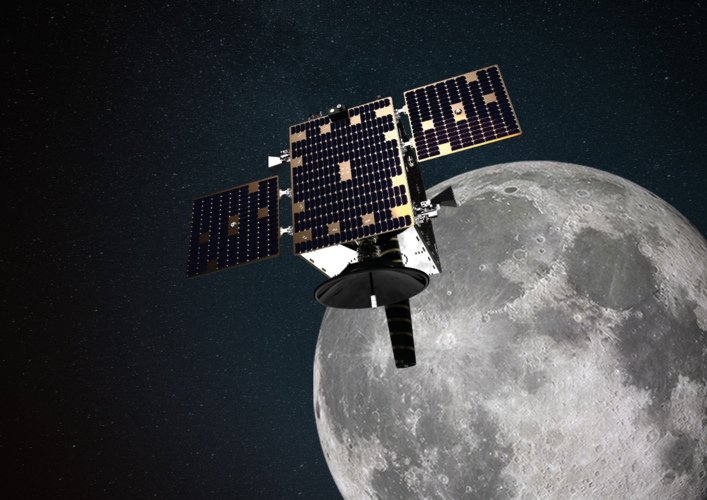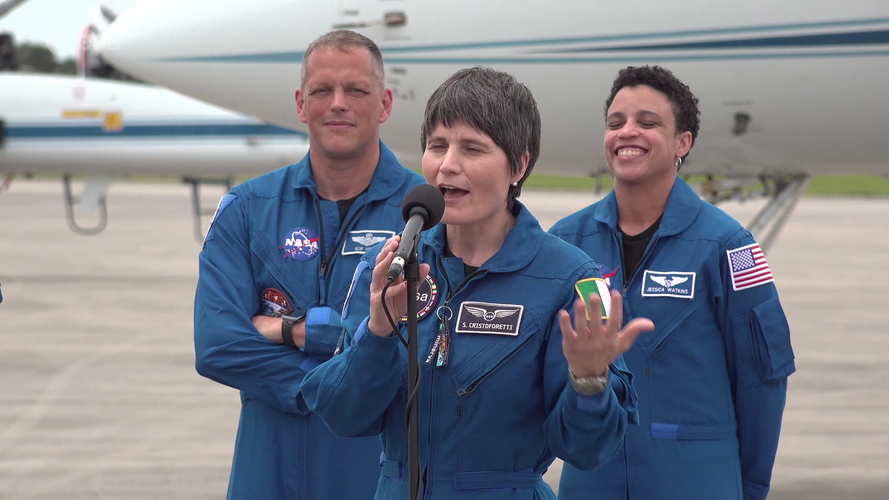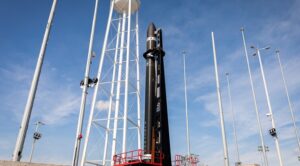OneWeb signs contract to launch satellites from India in 2022
Wednesday, 20 April 2022 19:35
OneWeb has signed a contract to use India’s largest launch vehicle to deploy at least some of its remaining LEO broadband satellites this year, according to a company executive.
The post OneWeb signs contract to launch satellites from India in 2022 appeared first on SpaceNews.
Sun releases moderate and strong solar flares
Wednesday, 20 April 2022 19:12
The Sun emitted two solar flares on April 19, 2022, one moderate peaking at 9:35 p.m.
NASA's Perseverance rover captures video of solar eclipse on Mars
Wednesday, 20 April 2022 17:07
NASA's Perseverance Mars rover has captured dramatic footage of Phobos, Mars' potato-shaped moon, crossing the face of the Sun. These observations can help scientists better understand the moon's orbit and how its gravity pulls on the Martian surface, ultimately shaping the Red Planet's crust and mantle.
Captured with Perseverance's next-generation Mastcam-Z camera on April 2, the 397th Martian day, or sol, of the mission, the eclipse lasted a little over 40 seconds—much shorter than a typical solar eclipse involving Earth's Moon. (Phobos is about 157 times smaller than Earth's Moon. Mars' other moon, Deimos, is even smaller.)
The images are the latest in a long history of NASA spacecraft capturing solar eclipses on Mars. Back in 2004, the twin NASA rovers Spirit and Opportunity took the first time-lapse photos of Phobos during a solar eclipse. Curiosity continued the trend with videos shot by its Mastcam camera system.
But Perseverance, which landed in February 2021, has provided the most zoomed-in video of a Phobos solar eclipse yet—and at the highest-frame rate ever.
Canada’s answer to Space Force
Wednesday, 20 April 2022 14:27
Canada’s military will establish a new space division later this year as it further develops its capabilities and skills for space operations.
The post Canada’s answer to Space Force appeared first on SpaceNews.
Sci-fi becomes real life: NASA doctor 'holoports' to International Space Station
Wednesday, 20 April 2022 14:10
Star Wars turned into real life? A NASA doctor appeared as a hologram at the International Space Station for a telemedicine visit with an astronaut in Oct. 8, 2021, according to a recent release from NASA.
The "holoportation", a word made from hologram and transportation, features a life-like visual and audio connection between the space center and those back on Earth.
Dr. Josef Schmid and his crew were holoported to the ISS using the Microsoft Hololens Kinect camera and a personal computer with custom software Aexa, according to an April 8 release from NASA. Schmid had a virtual conversation with astronaut Thomas Pesquet as part of a 3D telemedicine visit.
"We'll use this for our private medical conferences, private psychiatric conferences, private family conferences and to bring VIPs onto the space station to visit with astronauts," Schmid said.
The technology allows users to interact with remote participants in 3D as if they were physically in the same space.
"It is a brand new way of human exploration, where our human entity is able to travel off the planet.
Using bacteria to build settlements on Mars
Wednesday, 20 April 2022 13:56
In collaboration with the Indian Space Research Organization (ISRO), a team of researchers from the Indian Institute of Science (IISc) has developed a sustainable method for making bricks out of Martian soil, using bacteria and urea. These "space bricks" can be used to construct building-like structures on Mars that could facilitate human settlement on the red planet.
The method for making these space bricks has been outlined in a study published in PLOS ONE. A slurry is first created by mixing Martian soil with guar gum, a bacterium called Sporosarcina pasteurii, urea and nickel chloride (NiCl2). This slurry can be poured into molds of any desired shape, and over a few days the bacteria convert the urea into crystals of calcium carbonate. These crystals, along with biopolymers secreted by the microbes, act as cement holding the soil particles together.
An advantage of this method is the reduced porosity of the bricks, which has been a problem with other methods used to consolidate Martian soil into bricks.
The Moon – where no satnav has gone before
Wednesday, 20 April 2022 12:29
The test version of a unique satellite navigation receiver has been delivered for integration testing on the Lunar Pathfinder spacecraft. The NaviMoon satnav receiver is designed to perform the farthest ever positioning fix from Earth, employing signals that will be millions of times fainter than those used by our smartphones or cars.
Extraterrestrial mining would emulate 'tears of wine' phenomenon
Wednesday, 20 April 2022 11:26
Tears of wine is a phenomenon frequently observed as a ring of wine formed near the top of the glass generates droplets that fall back into the wine. This phenomenon can be explained by the Marangoni effect driven by the surface tension created via gradients on concentration and temperature along the interface between two phases.
In a paper published in Advances in Space Research, Jonathan Whitlow, an associate professor in biomedical and chemical engineering and sciences, and co-authors propose an extraterrestrial all-in-one mining process in which the Marangoni effect would allow non-mechanical transportation of the extraterrestrial mineral to feed an also in-situ pyrolysis-based refinery unit.
The researchers seek to establish that the Marangoni effect, which is crucial for welding metals, manufacturing integrated circuits and growing crystals, has the potential to be important for supporting lunar habitats and other extraterrestrial endeavors. They contend that vacuum and reduced gravity are expected to augment the Marangoni effect on extraterrestrial molten soil leading to sustainable extraterrestrial in-situ resources utilization.
Crew-4 arrive at Kennedy Space Center
Wednesday, 20 April 2022 11:00 Video:
00:06:28
Video:
00:06:28
ESA astronaut Samantha Cristoforetti arrives at NASA’s Kennedy Space Center in Florida, USA, with NASA astronauts Kjell Lindgren, Bob Hines and Jessica Watkins on 18 April 2022.
Collectively known as Crew-4, the astronauts flew in from Houston, Texas, and will spend the next week in quarantine before being launched to the International Space Station on a SpaceX Crew Dragon spacecraft.
When they arrive at the Station, Samantha’s Minerva mission will officially begin. This is the second long-duration space mission for Samantha who first flew to the orbital outpost in 2014 for her Italian Space Agency ASI-sponsored mission Futura.
Samantha will
Weather delays Ax-1 return
Wednesday, 20 April 2022 09:45
Poor weather will delay the return to Earth of four private astronauts from the International Space Station, which could in turn push back the launch of the next set of NASA and ESA astronauts to the station.
Rocket Lab to launch HawkEye 360 satellites on first Wallops Electron mission
Wednesday, 20 April 2022 09:02
The long-delayed first launch of a Rocket Lab Electron rocket from Virginia is now scheduled for late this year, carrying satellites for HawkEye 360.
The post Rocket Lab to launch HawkEye 360 satellites on first Wallops Electron mission appeared first on SpaceNews.
Op-ed | Space entrepreneurs need straight answers from DoD
Wednesday, 20 April 2022 09:00
Many space technologies developed by entrepreneurs haven't been allowed a proverbial seat at the table, says industry executive Charles Beames
The post Op-ed | Space entrepreneurs need straight answers from DoD appeared first on SpaceNews.
Weather satellite prepares for lightning
Wednesday, 20 April 2022 08:34
As one of the last milestones before liftoff at the end of the year, the first Meteosat Third Generation weather satellite is being fitted with its Lightning Imager. From geostationary orbit, 36 000 km above Earth’s surface, this state-of-the-art European instrument will continuously monitor lightning over more than 80% of Earth’s disc for early warnings of dangerous storms. Remarkably, it is capable of imaging relatively weak lightning events in full sunlight.
Kamala Harris announces U.S. ban on anti-satellite missile tests
Wednesday, 20 April 2022 07:32 Vice President Kamala Harris announced the United States' commitment to not conduct anti-satellite missile tests, making it the first country to institute the self-imposed ban against the destruction of orbitals that jeopardize the long-term sustainability of space.
"Simply put, these tests are dangerous and we will not conduct them," she said.
Harris announced the ban Monday night b
Vice President Kamala Harris announced the United States' commitment to not conduct anti-satellite missile tests, making it the first country to institute the self-imposed ban against the destruction of orbitals that jeopardize the long-term sustainability of space.
"Simply put, these tests are dangerous and we will not conduct them," she said.
Harris announced the ban Monday night b Glide Breaker Program Enters New Phase
Wednesday, 20 April 2022 07:32 DARPA is seeking innovative proposals to conduct wind tunnel and flight testing of jet interaction effects for Phase 2 of the Glide Breaker program. The overall goal of Glide Breaker is to advance the United States' ability to counter emerging hypersonic threats.
Phase 1 of the program focused on developing and demonstrating a divert and attitude control system (DACS) that enables a kill v
DARPA is seeking innovative proposals to conduct wind tunnel and flight testing of jet interaction effects for Phase 2 of the Glide Breaker program. The overall goal of Glide Breaker is to advance the United States' ability to counter emerging hypersonic threats.
Phase 1 of the program focused on developing and demonstrating a divert and attitude control system (DACS) that enables a kill v 
